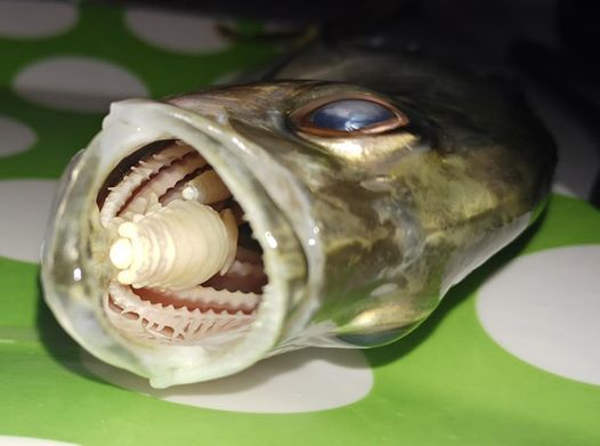Cymothoa exigua, popularly known as the tongue-eating louse, is a parasitic isopod that attaches itself to the tongue of its fish host, severs circulation, causing the organ to necrose and fall off, and then becomes the new tongue.
We’ve covered a bunch of terrifying parasites on Oddity Central, but few can hold a candle to the tongue-eating louse in terms of creepiness. This critter is one of the few that actually does the phrase “what nightmares are made of” justice. It enters fish through the gills, attaching to them until it matures, at which point it changes sex from male to female. Once this process is complete, the parasite starts to make its way to the fish’s mouth, where it attaches itself to its tongue using its incredibly powerful legs. It then pierces the host’s tongue with its strong bite and begins to suck the blood out of it. The blood vessels can’t keep up with their appetite, and the tongue eventually withers and detaches from the fish.

Photo: Elkin Fricke/Wikimedia Commons
Losing its tongue does not kill the host. Remarkably, the tongue-eating louse becomes a replacement for the organ, sort of like a prosthetic. It sounds hard to believe, but the fish can survive just fine and even thrive with this rather large parasite for a tongue. Cymothoa exigua is the only known organism to replace an entire organ of its host without killing it in the process.
After replacing the tongue of its host, the louse remains permanently attached to the stump of the tongue, surviving on mucus and bits of blood it finds in the mouth. As gross as it may sound, the mouth of the fish is the place where this creepy parasite reproduces. If any male louse enters the fish through the gills, it makes its way to the mouth, where it mates with the tongue-female, which then gives birth to a host of new parasites, causing the disgusting cycle to begin anew.
Cymothoa exigua is fairly widespread – from the Gulf of California to the Gulf of Guayaquill, in Ecuador, as well as in parts of the Atlantic – and prefers snappers as hosts, although it has so far been discovered as the tongue of seven species of fish.
The tongue-eating louse poses no serious danger to humans, except for the possibility of biting their fingers if they attempt to detach them from their hosts. That said, they used to be the main pretext for a lawsuit against a large supermarket chain in Puerto Rico, because many of the snappers commercialized by it had lice for tongues.
Plaintiffs claimed to have been poisoned by eating the isopod cooked inside the snapper, but charges were eventually dropped on the grounds that isopods are not poisonous to humans. Still, imagine finding one of these things inside the mouth of a cooked fish while you’re eating it…












